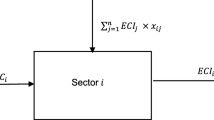Abstract
This paper builds an input–output table for carbon fiber industry chain in accordance with input–output theory. In order to get a clear picture of the dynamic input–output process between a variety of sectors involved in the carbon fiber industry chain and the increment of value hereinto, a Graphical Evaluation and Review Technique (GERT) network model is constructed on the basis of value flow, and an analytical algorithm for the GERT network model is proposed to get the value transfer probability, the amount of value increment, and the fluctuation variance, from which the equivalence value transfer process and results between sectors are obtained. Finally, in the case study part, this paper finds out the value transfer relationship within the carbon fiber industry chain in Jiangsu Province, China based on the empirical data gotten from field investigations, and then some constructive policy-making and investment suggestions are put forward in view of the results and analyses.


Similar content being viewed by others
References
Stewart, R.: Carbon fiber producers optimistic in downtown. Reinf. Plast. 54(1), 18–24 (2010)
Bozhang, Q.: Development trend of carbon fiber industry. Chem. Ind. 6, 13–20 (2011)
Yifeng, L.: Changing global carbon fiber industry pattern. Adv. Mater. Ind. 2, 1–6 (2012)
Lan, X.: SCP analysis of global carbon fiber industry. Sci. Technol. Manag. 1, 24–29 (2013)
Leontief, W.: Quantitative input-output relations in the economic system of the United States. Rev. Econ. Stat. 18, 14–19 (1936)
Yong, W.: Chinese input-output accounting: review and prospect. Stat. Res. 8, 65–73 (2012)
Guoqiang, H., Fuchang, C.: Research on input-output table of enterprise. Econ. Surv. 1, 81–83 (2003)
Yuncheng, F., et al.: Stochastic Network and Its Application. Beijing University of Aeronautics and Astronautics Press, Beijing (1987)
Golenko-Ginzburg, D., et al.: Resource constrained scheduling simulation model for alternative stochastic network projects. Math. Comput. Simul. 63(2), 105–117 (2003)
Abdi, R., et al.: Modeling and analysis of mechanization projects of wheat production by GERT networks. Agric. Sci. China 9(7), 1078–1083 (2010)
Weidong, Y., et al.: Grey GERT network model and its application in organizational information transfer. Shanghai Manag. Sci. 4, 54–59 (2014)
Zheng, Y.S., et al.: A study on the Hi-tech product development based on graphical evaluation and review technology. Syst. Eng. 11, 112–115 (2005)
Yi-song, Z., et al.: GERT-based project planning method for hi-tech product development. Ind. Eng. J. 10, 86–90 (2009)
Cheng-chuan, L.I., et al.: Uncertain remanufacturing process routings model for used components based on GERT network. Comput. Integr. Manuf. Syst. 2, 298–305 (2012)
Liu, Y., et al.: Diagnosis and detection of critical quality resources for complex products based on supplier GERT model. J. Ind. Eng. 2, 212–219 (2011)
Li, X.S., et al.: Research on weapon equipment development risk based on GERT network model. Syst. Simul. Technol. 4, 92–99 (2010)
Cheng, C.H.: Fuzzy repairable reliability based on fuzzy GERT. Microelectronics 36(10), 1557–1563 (1996)
Wang, C.N., et al.: Evaluating the manufacturing capability of a lithographic area. Exp. Syst. Appl. 38, 923–932 (2011)
Yang, B., et al.: Optimal resources allocation model for emergency rescue process based on the GERT network. Chin. J. Manag. 12, 1879–1889 (2011)
Jin, Z., et al.: Regional innovative technology talents training and policy designed GERT network model. Sci. Sci. Manag. S T 12, 144–152 (2011)
Wang, B., et al.: Regional knowledge innovation value-flow GERT network model. Sci. Technol. Prog. Policy 1, 39–44 (2015)
Geng, R., Zhu, J.: Optimization model for the joint of time and probability under the controlled result output of the GERT network. Syst. Eng. 4, 112–119 (2015)
Yu, B., et al.: A new GERT model and its application based on value flow process. Syst. Eng. 7, 43–48 (2009)
Yu, B., et al.: A combined C marker GERT network model and its application based on value flow process. Syst. Eng. 11, 91–95 (2009)
Yu, B.: Study on a new GERT network model and its application based on multiple transfer parameters. Nanjing University of Aeronautics and Astronautics, Nanjing
Guo, B., et al.: Multi-parameter GERT network model of leading industry choice based on energy efficiency perspective. Syst. Eng. Theor. Pract. 5, 944–953 (2011)
Das, S., et al.: Global Carbon Fiber Composites Supply Chain Competitiveness Analysis. Technical Report from Clean Energy Manufacturing Analysis Center, vol. 5, (2016)
Khayyam, H., et al.: Stochastic optimization models for energy management in carbonization process of carbon fiber production. Appl. Energy 11, 643–655 (2015)
Acknowledgements
This paper is sponsored by the National Natural Science Foundation of China (Nos. 71363046, 71271226, 71301064); the Humanistic and Social Science Youth Foundation of Ministry of Education of China (No. 13YJC790198); the basic scientific research fund of Nanjing University of Aeronautics and Astronautics (No. NP20150036).
Author information
Authors and Affiliations
Corresponding author
Ethics declarations
Conflict of interest
The authors declare that they have no financial and personal relationships with other people or organizations that can inappropriately influence their work, and there is no professional or other personal interest of any nature or kind in any product, service, and/ or company that could be construed as influencing the position presented in, or the review of, the paper.
Rights and permissions
About this article
Cite this article
Liu, X., Fang, Z. & Zhang, N. A value transfer GERT network model for carbon fiber industry chain based on input–output table. Cluster Comput 20, 2993–3001 (2017). https://doi.org/10.1007/s10586-017-0960-y
Received:
Revised:
Accepted:
Published:
Issue Date:
DOI: https://doi.org/10.1007/s10586-017-0960-y




